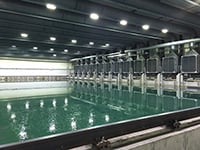 It is 40m square pool designed to simulate the conditions icebreaker boats and other sea craft face in the arctic. It is also a demonstration of the current limitations of computing.
It is 40m square pool designed to simulate the conditions icebreaker boats and other sea craft face in the arctic. It is also a demonstration of the current limitations of computing.
So why the the worlds biggest G and T? Given that full scale testing is hugely impractical, most of the boats are 1:31 size. But this means that 'normal' ice is too strong to correctly simulate sea conditions. The answer is to weaken the ice, and that is done with... alcohol.
The world's biggest 3d (Ice) printer? To build the ice sheets on the pool a straddling movable bridge sprays small water droplets into air so cold that they freeze before they hit the water's surface. This is built up pass by pass until the appropriate depth is achieved. Admittedly it's not that interesting a shape, but it is a sort of 3d printing. The professor in charge laughed politely when I said it anyway...
The world's biggest freezer? Most test facilities for boats are long and thin, this tank is square, cold and huge. There's one of comparable size in Korea, but this makes even the biggest Zanussi look like small fry.
I asked the professor what the issue with digital modelling is. He assured me that digital modelling is concurrently being researched with these physical simulations, but, as yet, an accurate enough model has not been produced. When ice impacts stationary structures or boats it breaks down, fractures and cracks in a chaotic, stochastic way, the complexity of which has proved resistant to modelling as yet.
This facility brings together research, computing and real-life in a way that has huge practical benefit to a country that relies on its seaports for 90 per cent of its external trade.

















